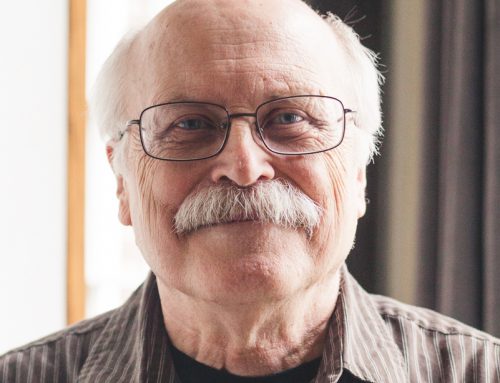I grew up in the ’50s and early ’60s. Looking back, I feel as if I witnessed the sunset of virtue in our society. As the end of our century fast approaches, I am trying to make sense of my life in the new darkness of our western culture which for centuries grounded its vision of human existence–as individuals and as a society–on ideals called virtues.
Webster’s dictionary defines a virtue as: “conformity to a standard of right; morality; a particular moral excellence.” Virtues are ideals people hold as standards by which to pattern their lives. Yet our culture’s intellectually and popularly accepted concepts of virtue have eroded almost to non-existence. They are faint vapors on our horizons from our civilizational past. The metaphor of “darkness” aptly describes this erosion of a socially and culturally accepted set of virtues. And the darkness is deepening.
Where is this darkness rising?
This darkness has always been. Until now, however, it has always drawn our collective cultural contempt and strongest resistance. The situation has changed. Our current social experience evinces an acquiescence–even embracing–of darkness at two levels: first, in the realm of “high art,” and second, in the art of popular culture, primarily television programming and popular music, especially Rock music.
The arts–in which our individual and aggregate human cultures speak–do not lie. Though the language of a particular art form can be difficult to learn, once learned, it inevitably tells the truth about the character and moral vision of the human heart–or of a particular human heart–in unusually poignant and powerful ways.
For centuries the role of art–visual, musical, and literary–was commonly understood to be that of calling us to an awareness of things deemed beautiful, worthy, and philosophically or religiously important. Even art commissioned by a wealthy individual or a particular church or royalty was commissioned with the motivation that many would see it or hear it or read it and be “bettered.” Such art was not always “pretty.” Often the subject matter depicted gruesome executions, wickedness, cruelty, or tragedy. But the artist intended to use such renderings of darkness and evil, as well as renderings of beautiful or ideal scenes, to teach us about ideals and truths, which if believed and emulated would lead one to strive for what all would agree was a good, or virtuous, life.
During the Romantic period of the arts, which extended from the last half of the eighteenth century into the middle of the nineteenth, an inversion of moral vision was born. The Romantics, convinced that the highest paths to truth are located in the irrational side of man’s psychic life, began to explore the inner darkness of human subjectivity. The mysteries of man’s inner visions, dreams, even the darker side of human sexuality and cruelty were pondered and explored for their emotional “truth.” According to this perspective, truth worth exploring is not the exclusive domain of traditionally accepted notions of objective ideals or beauty. Truth for the Romantics was inwardly and individually created and ultimately rested its authoritative foundations upon human subjectivity, not on rationally defensible objective universals. The Romantics opened the door to the “darkness” in high arts, casting the seeds for a cultural moral revolution.
Following the Romantics, the early era of “Modernism” expanded the acceptance and influence of subjective, relative truth created in and for oneself. The early Moderns embraced and deepened the notion that the arts, as a specially potent human language, should use and explore the darker side of the human condition in order to “shock” human consciousness from its complacent, ignorant acceptance of “middle-class” virtue. According to this Nietzschean precept, the ordinary, common-sense, traditional, religiously-based morality blinded and prevented man from attaining his Promethean potential to free himself to true authenticity and greatness. Man could rise above the ordinary, manifest his potential for glory, but only through the realization that he needed to become “Superman” by casting aside western and, especially, Judeo-Christian ideals of virtue.
Since human art manifests and depicts a vision of life, so art reflected the rejection of traditional morality. At first the art of the Impressionists and Post-Impressionists portrayed mild versions of the epistemological and moral revolution begun by the Romantics. Increasingly, however, artistic explorations depicted not only the crisis of knowledge and perception undergirding the moral inversion, but also subject matter and fruit of the darkness and corruption itself. For only through this shocking depiction could society be shaken from its thoughtless adoption of middle-class inauthenticity and evolve to a higher level of consciousness wherein true human freedom is experienced by all. In the wake of this perspective, decadent behavior in theater performance, adoption of atonal musical systems, and the use of ordinary and mean objects such as urinals as art objects became the new “languages” of Modernism’s “avant-garde.” This avant-garde captured and galvanized the high arts of western civilization for their own ideological causes, specifically the transcendence of flawed humanity through the embracing of a subjective, nihilistic posture toward traditional wisdom and virtue.
In our culture, which is increasingly one of visual and image-based consciousness, Modernism’s avant-garde movement has now captured the center of our most influential and popular art forms and media. Our centers of art and media training and production–art colleges, institutes, and universities–have uniformly embraced the avant-garde ideology and myth. Consequently, we should not be surprised by the turn of events in the darkening of our culture’s vision of things human.
In a recent and quite fascinating essay entitled, “White Trash Nation,” writer Ted Friend argues that, indeed, the 1990s icons of our popular culture can best be described as immoral, uncaring, hopeless renegades bent on every form of self-indulgence within their grasp. Promiscuous sex, violence, and anti-social attitudes form what Friend says are at the center of the “white-trash” mentality of “Rosanne,” “Married With Children,” “The Simpsons,” and MTV’s “Beavus and Butthead.” These wildly successful sitcom programs and media personas are presented to us as the latest, hippest, versions of ultra-cool images by which we should be “entertained.” And so Rosanne’s ex-husband, Tom Arnold, has declared, “We are America’s worst nightmare: white trash with money.”
In her recent, very insightful book, Hole in Our Soul: The Loss of Beauty and Meaning in American Popular Music, Martha Bayles demonstrates the connections between nineteenth century Modernism’s avant-garde artistic theories and the emergence in the 1960s of anti-social, bohemian, eccentric, and darkly enigmatic art forms into the mainstream of American youth culture. The reality of this phenomenon is obvious in the visual and pop-literature nature of the enormously popular “bibles” of hip culture and music: Rollingstone and Spin magazines.
In the avant-garde Modernist purview, the outrage and public rejection of an artist’s work is the badge of its validity and authenticity as a “serious work of art”; serious, “high” art cannot be tainted with popular acceptance. Contrary to this myth of the avant-garde, Martha Bayles argues that our true and best art can be popular as well. Serious art forms, especially in music and cinema, she argues, can begin from a commercial base and find enormous public acceptance and recognition. Over time, not only the popular crowd, but also the critics and scholars recognize certain “popular” works as authentic, enduring works of art. Consider the contemporary recognition, for example, of some of the enormously popular and artistically proven films of the 1930s and 1940s or Duke Ellington’s marvelously popular works in swing and jazz music. In today’s visual, media-dominated society, this means that popular, widely viewed and listened to art forms can have an enormous impact for good or ill.
Pulp Fiction, a recent film by Quentin Tarantino, illustrates this well. Tarantino, an extraordinary story teller and film maker, is considered by many to be the newest artistic genius in his cinematic art form. His enormous giftedness at making films is not questioned. But his vision of life–of what should be important, vital, and basic to the well-being of human existence–is, in my view, open to question. Here is the rub as I see it: that artistic genius–especially in a culture-creating art media such as contemporary cinema–can stand side by side with a moral vacuity of mind and heart that exploits and accentuates human darkness under the “mandate” of artistic freedom and creativity. With a talent possessed by only a few, an artist like Tarantino, through his depictions of graphic human violence, meaningless and impersonal sexual behavior, and normalized criminality, creates a mind-bending portrayal of dark human behavior which confuses and numbs our common-sense understandings of what is good, beautiful, and worth pursuing in this life. Having seen a film like Pulp Fiction, we sit stunned and amazed by Tarantino’s shattering images and brilliant staccato character dialogues. But our vision of what it means to be human has been raped and pillaged by his artistic genius. The darkness rises.
Tragically, American culture is succumbing to a numbing and dumbing down. Is there any correlation between the fading of the commonsensical and once widely held belief in the existence of virtues on the one hand and the appalling level of ignorance that our educational social scientists are informing us of on the other? Do ignorance and violence go together somehow? As we become a culture and society whose ability to perceive, think, know, and analyze ideas becomes linked and limited inextricably to images rather than words, the images of sound and sight set the boundaries of our conceptual and usable vocabulary.
At a time in history when we are swamped in both intellectual and popular arenas of our culture by the myths and artistic tenets of Modern “avant-gardism,” we need to set a clear-eyed and clear-minded watch-guard for ourselves. We can argue among ourselves over the merits of listening more attentively to the “right side” of our conceptual knowing processes, the side associated with artistic, visual, and intuitive logic. Or we can argue equally that to diminish the control of the “left side,” associated with rational, linear logic, is to invite chaos and meaninglessness. In our “multi-culture, multi-reality” times, to become overly influenced by the visual at the expense of the verbal is to invite a kind of ignorance, a kind of visually-based barbarism to rise and lead us further into the dark. This barbarism is capable of numbing us to the virtues and beauty God created into His creature and His world. We are also in danger of being dumbed-down by a “visualization” of reality in which we lose our ability to learn and to conceptualize in words which expand our mind’s working vocabulary and expose us to ideas that foster in us a taste for goodness. Our cultural substance is in danger of turning to empty, dark stagecraft.
The believer’s response to this darkness
Many in our contemporary society are sounding the alarm at the emergence of this precipitating darkness. Many political and cultural conservatives and moderates are speaking into the voids, warning us of virtue’s dimming. Culture wars are afoot, and in my analysis above I no doubt have much in common with those who are shocked and frightened by the loss of our concept of virtue. Permit me, at this point, to raise what for me seems a more important and difficult issue: How should believers in the Christ respond to the reality of this rising darkness?
Most Christians would analyze the situation much the same as I have above. Many would use such an analysis to preach the need for a variety of “activ-isms,” such as evangelism, political and social action projects, and the desperate need for alternative educational strategies to preserve our children and the next generation in the midst of darkness. Our call to pursue righteousness requires that we stand against the darkness not only in its personal forms, but in all its social and cultural forms as well. But what advice, hope, and comfort does the Gospel give to us that conservative cultural and political philosophy and action does not?
Simply put, our Creator God is not afraid of the dark. He is bigger than the dark. God uses the dark on His dark creatures to give them a deep love of the light; He uses the dark to teach the truth to those He has chosen to gift with life. In Romans, chapter seven, while the Apostle Paul makes clear that He loves the light, he also makes clear that a horrible, besetting darkness resides in him, a darkness that only His savior can overcome. And, says Paul, thanks be to God, for He has chosen to do that for His children.
God transcends the dark, and yet He has permitted it for His own wise purposes. He miraculously uses the dark to save us, and that fact tells us something about Him and true goodness. He is the totally Unexpected Good, able to transform the darkness into light. Witness the manner in which God chose to redeem us. The murderous slaughtering of a perfect human being–the apparent triumph of deep darkness, wickedness, and rebellion–inverted, transformed into the totally unexpected triumph of the light. The darkness worked, was used, was subverted by the power of God’s loving might.
God has not spared His use of my own darkness to show me the true nature of my corruption. In fact, those times of utter moral failure have proven to be the most shatteringly profound, though painful, lessons leading me to the light.
We ache in this darkness. We have this deeply buried pain because He has mercifully chosen us, and it is His means of teaching us the true value of goodness. It is an integral part of His way of transforming us from children of the darkness to children of the light. He uses the dark against itself on behalf of His beloved children as He works the miracle of rebirth and glorious destiny in them.
What is the antidote for the darkness innate to our fallen, rebellious humanness? It is the miracle performed in our hearts rendering us creatures that hate the dark and come to the light in spite of the fact that darkness still rules much of our minds and hearts.
When we see and feel the deepening darkness around us, we shudder–and appropriately so. We fight against it–and appropriately so. We are sometimes overcome by it. But we do not despair, because we have clear evidence that our Savior-God, who hates and will overcome the darkness, has chosen to use it against itself. We have hope, the Gospel reminds us, in the midst of the rising darkness. And we are miraculously free to celebrate the eventual, but certain, rising of the Light.






